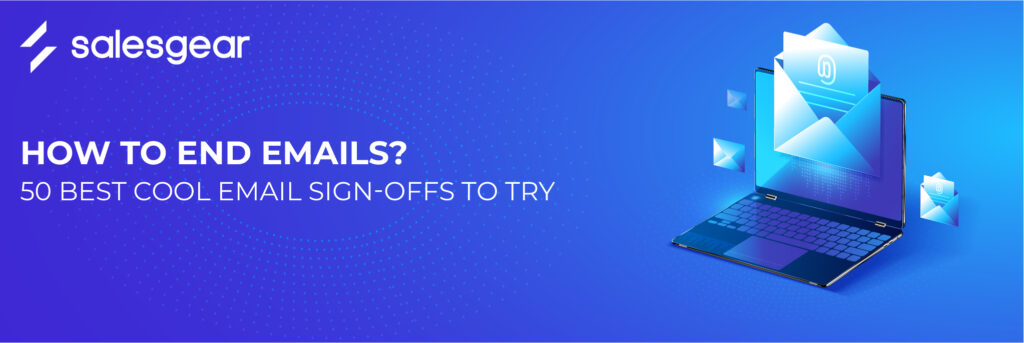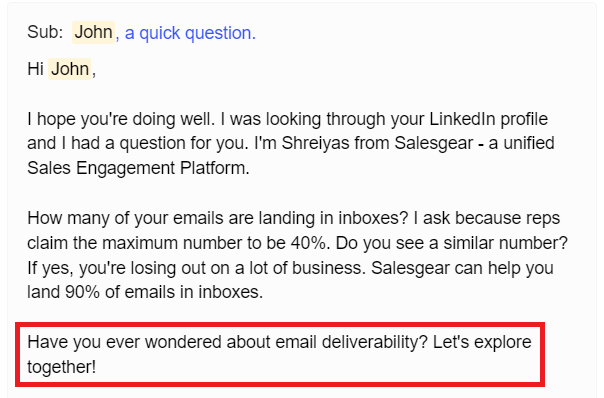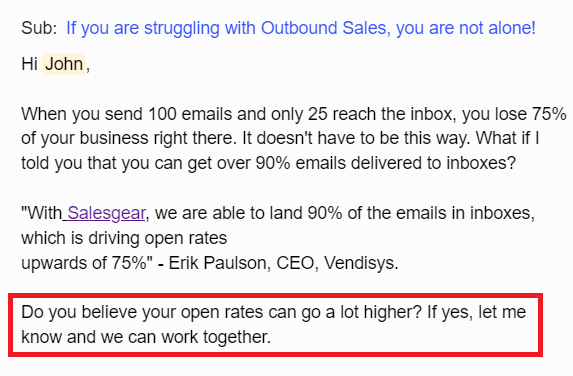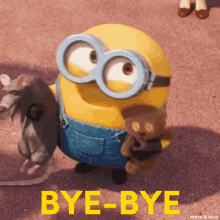
According to Campaign Monitor, an average executive receives about 121 emails daily, making it increasingly difficult for you to draft emails that stand out from the noise. Yet, we know how essential an email is for reaching out to potential buyers. While the subject line and starting off right is undoubtedly crucial for a cold email, many often overlook closing on the right note. Worry not! This blog has some ‘cool email sign-offs for you to level up your cold email game.
Let’s dive into the art of crafting compelling email sign-offs that leave a lasting impression and pave the way for successful business engagements.
What is an Email Sign off?
Email sign-offs, also known as email closings or valedictions, are phrases or expressions used to conclude an email message. They are typically placed at the end of an email, after the body of the message. Email sign-offs serve multiple purposes, including providing a polite and professional ending, expressing gratitude or appreciation, or indicating the sender’s intentions or next steps. Some of the common Sign-offs used to end emails:
1. Best regards
2. Sincerely
3. Regards
4. Kind regards
5. Thanks
These sign-offs are meant to convey a sense of courtesy, respect, and professionalism. The choice of sign-off may vary depending on the nature of the email and the relationship between the sender and recipient. While these are the commonly used sign-offs, you can use unique and cool sign-offs for emails.
How to Choose an Email Sign-Off?
Choosing an email sign-off involves considering several factors to ensure it aligns with your message and the recipient. When selecting an email sign-off, it’s crucial to strike a balance between professionalism, tone, and context. Consider the nature of your relationship with the recipient and the purpose of your email.
Do your due research on the recipient’s preferences and cultural norms, as some may favor more formal sign-offs. Additionally, if your email requires a specific action or response, include a clear call to action in your sign-off. Experiment with different sign-offs to gauge their impact on response rates, and be open to adjusting based on individual or industry preferences. Ultimately, the chosen sign-off should convey professionalism, appreciation, and respect while reflecting your personal style and the context of the communication.
Top 50 Cool Email Sign-offs for You to Try
If you’re looking for creative email sign-offs that add a personal touch, remember to consider your audience and the context of your email. While they can be cool and refreshing, always maintain professionalism. Ensure that the sign-off aligns with the tone of the email communication.
Some of the best Ever-trending Pop Culture References:
If you want to add a touch of pop culture flair to your email sign-offs, here are some examples that incorporate references from movies, TV shows, or other elements of popular culture:
- May the Force be with you always.
- Live long and prosper.
- “I’ll be back” with a response soon.
- May your inbox be as magical as Hogwarts.
- Hasta la vista, baby! Looking forward to your reply.
- May your emails be ever in your favor.
- YOLO!
Some Compliments to Give While Signing off Emails:
Signing off an email with a compliment could make the prospect happy and will keep them interested in your product or services.
Keep in mind to be genuine and specific about the compliment. Make sure it sits well with the rest of the email. This personalized touch will demonstrate your attentiveness and genuine interest, setting a positive tone for the rest of the email.
- Your expertise on this matter is truly impressive.
- I appreciate your creativity and dedication.
- It’s been a pleasure working with someone as talented as you.
- I’m constantly inspired by your innovative approach!
- Your positive attitude is contagious.
- Keep up the good work!
- You’re a true rockstar!
- Congratulations!
- To up and above!
- Stay positive!
Curiosity-driven Email sign-offs:
Piquing curiosity while ending an email is the best way to sign off. Using creative sign-offs like these encourages the recipients to respond to the emails. You could end your email with a question or a statement that leaves them wanting to know more, here are a few examples of curiosity-driven sign-offs:
- I have an intriguing idea to share. What are your thoughts?
- Want to hear something fascinating? Let’s connect!
- I’ve got an exciting proposition for you. Interested?
- Curiosity killed the cat, but it might lead to something amazing. Care to find out?
- Ready for a mind-bending revelation? Brace yourself!
- Have you ever wondered about email deliverability? Let’s explore together!

Action Trigger Email Sign-offs:
Having a clear Call-to-action that triggers an action in your emails is one of the best ways to end a cold email. It guides your prospects in understanding your intention of sending the email. Clear CTAs help them in deciding on the next step. Remember to keep your call to action clear, concise, and specific. Use actionable language and make it easy for the recipient to respond or take the desired action.
By being specific and outlining the next steps, you make it easier for the recipient to respond or engage further, increasing the chances of getting the desired outcome from your email communication.
- Please let me know your availability for a quick call or meeting
If you’re interested in getting on a call with the prospects, this is the best way to sign-off your cold email. It clearly states your intentions and elicits a response. - I look forward to hearing your thoughts on this matter
The intention of this sign-off is to get feedback or an opinion on the subject described in the email. This email sign-off keeps the prospect engaged and keeps the email conversational.
- If you’re interested, click the link below to learn more
The call to action in this sign-off is crystal clear, and asking the prospect to click on the link given in the email, is measurable hence a good sign-off to have in your emails.
- Feel free to reply with any questions or concerns you may have
The sender is being consultative and not pushy. This is a great way to sign off as it expects the prospects to clarify any doubts they may have.
- I’ll follow up with a call next week to discuss further
You can use this sign-off to clearly state your next steps to follow up on the matter discussed over email or call. It is used where the relationship with the prospect is already established.
- Do you believe [Pain point you solve] is a problem? If yes, let me know and we can work together
Since the question is very specific and caters to the needs of the recipient, it attracts a lot of replies. The email sign-off isn’t pushy, so if the prospect replies, you can learn more about the prospect.

Assistance-oriented Email sign-offs:
Offering assistance while signing off a cold email shows you are willing to provide support to the prospects. It shows that you’re not solely focused on making a sale but genuinely interested in helping them address their challenges or achieve their goals.
Let the recipient know that you’re available to answer any questions, provide additional information, or offer support if needed. Remember, signing off your cold email on a positive and genuine note can increase your chances of receiving a response.
- Let me know if there’s anything I can do to help.
- If you need further clarification, feel free to reach out.
- Should you require any additional resources, please don’t hesitate to ask.
- I’ll be more than happy to provide any assistance you may need.
- I’m here to make this process as smooth as possible for you. Let me know how I can assist.
- I’m at your disposal for any questions or concerns you may have.
- Should you require support in implementing these changes, I’m here to assist.
- If you would like guidance on the best course of action, I’m ready to lend a hand.
- Please consider me a resource for any assistance you may require.
- I’m eager to help you overcome any challenges you may face. Let’s tackle them together.
Personalized Email sign-offs:
Personalizations are a much cooler way to sign off emails. You can make your emails more engaging and show that you’ve taken the time to understand the recipient. By incorporating personal details, such as
- Hobbies,
- Favorite drinks,
- Specific projects,
- Achievements and shared experiences,
- Loved books, movies, etc.
These sign-offs create a personalized connection that shows you value and appreciate the individual. Remember to be genuine and authentic in your personalization efforts to foster stronger relationships and meaningful communication.
- Looking forward to catching up over coffee
- It would be a pleasure to catch up with a fellow [common interest]
- Let’s catch up over a [game of football, ping-pong, or basketball]
- Congratulations on your well-deserved promotion
- Your commitment to customer satisfaction is exceptional
Other Creative Email Sign-offs:
There are other cool email sign-offs that will pique prospect’s interest. These creative sign-offs inject a sense of fun, positivity, and originality into your emails. Feel free to customize them further to match your own unique style and the tone of your communication.
Humorous Email Sign-offs: These are best used when the potential buyer knows you and your sense of humor.
> See you later, alligator!
> Thank God it’s Friday!
>And that’s a wrap!
Emojis, Pictures, or GIFs: These are probably the coolest email sign-offs. They grab the attention of the recipients immediately and create a long-lasting impression.
> An emoji with Sunglasses
> An funny image

>Bye-bye GIF

Conclusion
Mastering the art of cool email sign-offs is a skill you want to develop to improve your outreach and results. Closing an email on the right note is as important as the subject line and opening line. The responses to your emails, be they positive or negative, could depend heavily on how sign off an email. So it is imperative that you close an email on high, to compile an effective email.
By implementing these techniques of ending an email, you can stand out from the sea of emails and increase your chances of eliciting a response. Remember, the effectiveness of a sign-off depends on various factors, such as your email content, the recipient’s preferences, and the context of your outreach. It’s always a good idea to test different sign-offs and track your response rates to determine what works best for your specific audience.